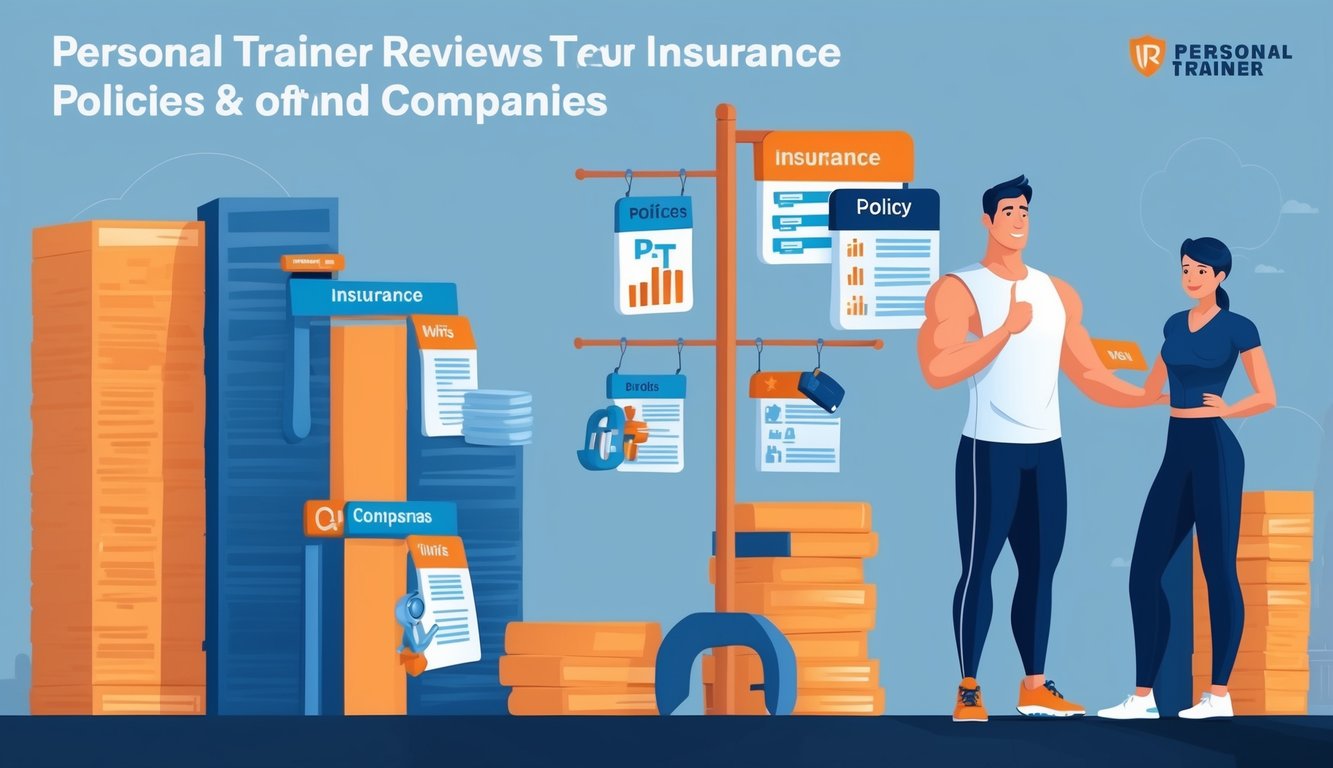Understanding Liability Insurance for Personal Trainers
Liability insurance is essential for personal trainers as it shields you from financial risks.
You need to understand the two main types of coverage and the specifics regarding limits and exclusions that could affect your practice.
Differentiating General and Professional Liability Coverage
General liability insurance protects you from claims related to accidents or injuries that occur on your premises.
This could involve a client slipping or falling during a session.
With this coverage, your insurance can help cover legal fees and medical expenses.
Professional liability insurance, on the other hand, focuses on claims arising from your professional services.
This includes potential client injuries resulting from improper advice or training methods.
It covers legal costs if a client sues you for negligence or errors in your service.
Understanding both types of coverage is vital.
Think of general liability as your first line of defense against physical accidents, while professional liability safeguards your reputation and financial standing against claims related to your expertise.
Exploring Coverage Limits and Exclusions
Liability coverage is not limitless.
Each type of insurance has specific coverage limits.
For instance, your general liability insurance might cover up to $1 million per occurrence but may have an annual cap of $2 million.
Always check your policy’s details.
Exclusions are another critical aspect to understand.
For example, many policies won’t cover intentional harm or negligence.
Some might not include coverage during unlicensed training sessions or outside of normal operating conditions.
It’s crucial to read the fine print of your policy to know what is and isn’t covered.
Evaluating Insurance Needs for Fitness Professionals
When you assess your insurance needs as a fitness professional, consider the specific risks associated with your work.
Understanding the potential for bodily injury and property damage is crucial, as is recognizing how your location and business property impact your coverage.
Assessing Risks of Bodily Injury and Property Damage
As a personal trainer, you face various risks that could lead to bodily injury.
This includes accidents during training sessions or equipment-related mishaps.
If a client is injured because of your advice or oversight, you could be liable for medical costs.
Property damage is another aspect to consider.
If damage occurs to equipment or facilities you use, this can also result in costly liability claims.
To protect yourself, it is wise to acquire professional liability insurance.
This type of coverage can help manage the costs from legal claims related to bodily injury or negligence.
Considering the Impact of Location and Business Property
Your location significantly influences your insurance needs.
If you train clients in a gym, you may need coverage that aligns with the gym’s insurance policy.
Conversely, if you operate independently, like in your home or outdoors, your coverage requirements could differ.
Evaluate your business property as well.
If you own equipment or have a dedicated workout space, ensure that your insurance covers theft, damage, or accidents.
Assess local laws and regulations, as they may affect your insurance obligations.
Coverage options can vary, so understanding how these factors relate to risks will help you select the right policy.
Insurance Coverage Options and Riders
When considering liability insurance as a personal trainer, it’s important to explore various coverage options.
Understanding specific policies and add-ons can help you better protect your business and clients.
Business Owner’s Policy (BOP) Benefits
A Business Owner’s Policy (BOP) combines multiple types of insurance into one package.
This often includes general liability insurance, property coverage, and business interruption insurance.
With a BOP, you typically receive lower premiums compared to purchasing each type of coverage separately.
This policy can protect you against claims of bodily injury, property damage, and personal injury.
Many insurers, like The Hartford, offer BOPs tailored for fitness professionals, ensuring that your unique business needs are met.
Additionally, it’s important to confirm that the policy covers all your physical locations and any mobile services you provide.
Specialized Coverages: E&O, Cybersecurity, and Sexual Abuse Liability
Errors and Omissions (E&O) insurance is vital for personal trainers.
It protects you from claims alleging inadequate or negligent performance of your professional duties.
This is especially important if a client holds you responsible for an injury resulting from your advice or training methods.
Cybersecurity insurance safeguards against data breaches and cyberattacks.
As a trainer, you may store sensitive client information online.
This coverage helps mitigate financial losses if that data is compromised.
Sexual abuse liability insurance protects against allegations of sexual misconduct.
This type of insurance is particularly critical for professionals working closely with clients.
By securing a policy with this addition, you show commitment to client safety and trust in your practice.
Financial Aspects of Insurance for Personal Trainers

Understanding the financial factors that affect liability insurance can help you make informed decisions.
Knowing how costs are determined and how to minimize out-of-pocket expenses is crucial for maintaining your business’s financial health.
Understanding Insurance Cost Variables
Insurance costs can vary significantly based on several factors.
One key variable is the type of coverage you choose.
For instance, professional liability insurance may average $35 per month, while some policies could be more or less depending on coverage limits and services offered.
Other factors include your location, client base, and the specific activities you undertake as a trainer.
Insurers often assess risks associated with different fitness activities, which impacts the quote you receive.
Additionally, if you are a student personal trainer, you may qualify for lower rates, such as $59 annually.
Understanding these variables can help you find affordable prices while ensuring you have the necessary coverage.
Minimizing Out-of-Pocket Expenses Through Adequate Coverage
To lower your out-of-pocket expenses, consider obtaining adequate coverage that aligns with your specific needs.
Having the right liability insurance provides financial protection against potential claims.
Evaluate your policy’s coverage limits.
High limits can mean higher premiums but offer greater protection in case of serious incidents.
Finding a balance is essential.
Moreover, regularly comparing quotes from different providers helps you discover the most cost-effective plans.
Look for discounts available for particular certifications or group memberships, which can further reduce costs.
Ensuring you have comprehensive coverage protects not just your finances but also your reputation as a personal trainer.
Selecting an Insurance Company and Policy

Choosing the right insurance company and policy is crucial for personal trainers.
It helps protect you from potential liabilities that can arise in your practice.
By comparing quotes and reviewing policy details, you can secure the best coverage for your needs.
Comparing Quotes from Multiple Insurance Companies
Start by gathering quotes from several insurance providers.
Consider companies like Next Insurance, Nationwide, and Progressive for competitive rates.
Each company’s policy may vary in coverage limits and premiums.
Focus on key factors such as:
- Cost: Look for cost-effective options without compromising coverage.
- Coverage Types: Ensure the policy includes professional and general liability.
- Limits: Check if the policy limits meet your business’s needs, such as a $5 million aggregate limit, commonly offered by top insurers.
Consider using online tools or consulting with insurance agents to compare your options effectively.
Reviewing Certificates of Insurance and Policy Terms
Once you have selected potential insurance providers, review their certificates of insurance.
This document outlines the specifics of your coverage.
Look for important elements such as:
- Coverage Details: Confirm what is included and excluded in the policy.
- Claim Process: Understand how to file a claim and the response time.
- Cancellation Policy: Know the terms if you choose to switch providers later.
Be sure to read the fine print in policy documents.
Companies like The Hartford and Philadelphia insurance companies often have unique terms that can affect your insurance experience.
Understanding these details can help safeguard your assets and provide peace of mind as you work with clients.
Risk Management and Legal Considerations

When you work as a personal trainer, understanding risk management and legal considerations is crucial.
These areas help protect you and your clients from accidents and potential legal issues.
You need to be proactive in preventing incidents and prepared to handle claims if they arise.
Preventing Accidents and Mitigating Negligence
To prevent accidents, ensure that your training environment is safe and well-maintained.
Regularly inspect equipment for wear and tear.
It’s also essential to have proper insurance coverage that includes protection against negligence claims.
This is where liability insurance comes into play.
Being certified in CPR/AED is necessary too.
This certification not only enhances your credibility but also prepares you to respond effectively in emergencies.
Keep a clear record of your clients’ health histories and document all sessions.
This creates a claims history that can be invaluable if any legal issues arise.
Dealing with Lawsuits and Legal Claims
In the unfortunate event of a lawsuit, having liability insurance is essential.
It helps cover legal costs and protects your assets.
You should familiarize yourself with the process of handling legal claims.
If a client accuses you of negligence, stay calm and avoid admitting fault.
Contact your insurance provider immediately to start the claims process.
They can guide you on how to respond and what to do next.
Gather all relevant documentation, including session notes and safety protocols.
This can help you strengthen your defense.
Being proactive and prepared can make a significant difference in how legal matters unfold.
Frequently Asked Questions

When considering liability insurance for personal trainers, several important factors come into play.
You may have questions regarding cost, coverage, certifications, and available discounts.
Here are the details that can help clarify your concerns.
What factors influence the cost of liability insurance for personal trainers?
The cost of liability insurance can vary based on several factors.
Your location can significantly affect pricing due to regional regulations and risk levels.
Additionally, your experience, the number of clients you train, and any specialized services you offer can also impact the cost.
What is typically covered under a personal trainer liability insurance policy?
A typical personal trainer liability insurance policy covers claims related to injuries sustained by clients during sessions.
This includes allegations of negligence or improper advice leading to injury.
It may also cover legal fees and settlements if a claim is made against you.
What are the differences between professional and general liability insurance for personal trainers?
Professional liability insurance protects you against claims of negligence in your professional services.
General liability insurance covers claims related to bodily injury or property damage on your premises.
Personal trainers often need both types to ensure comprehensive coverage.
How do certifications like ISSA or ACE affect a personal trainer’s insurance needs?
Certifications such as ISSA or ACE demonstrate your expertise and professionalism.
Some insurance providers may offer better rates or coverage options to certified trainers.
Additionally, certain policies may require specific certifications to be eligible.
Are there any discounts available for personal trainers seeking liability insurance?
Yes, many insurance providers offer discounts for personal trainers.
These discounts may be available for certified trainers, those who belong to professional organizations, or who bundle multiple policies together.
Always ask your provider about available discounts.
How does liability insurance for personal trainers vary by provider, such as NASM or GEICO?
Liability insurance coverage and pricing can vary between different providers.
For instance, NASM may cater specifically to trainers with certain qualifications, while GEICO might provide more general coverage.
It’s essential to compare policies to find the one that best meets your needs.






